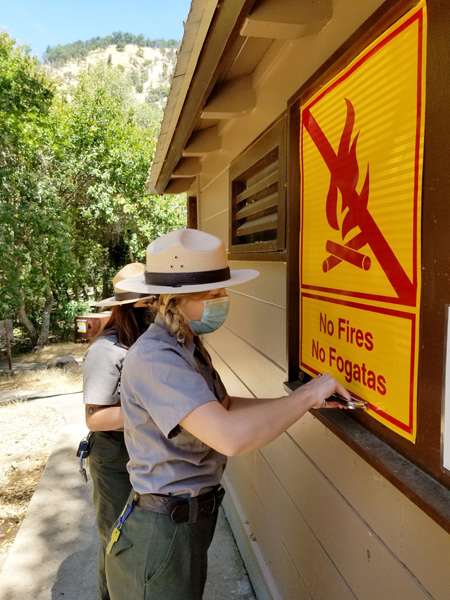November 5, 2020 - SEQUOIA AND KINGS CANYON NATIONAL PARKS, Calif. – Changes in long-term weather patterns and transition of seasons, along with the decrease in overall  visitation has reduced the threat of unwanted human-caused fires in higher elevation areas of Sequoia and Kings Canyon National Parks allowing the fire managers to reduce fire restrictions.
visitation has reduced the threat of unwanted human-caused fires in higher elevation areas of Sequoia and Kings Canyon National Parks allowing the fire managers to reduce fire restrictions.
(Left) National park rangers a No Fires sign to help prevent unwanted human-caused fires.
NPS / MTheune
While some areas are able to once again have campfires, the threat is not gone, especially at lower elevations. This year has seen record setting fire activity and until the parks get significant rainfall and snow, visitors to the parks must remain extra cautious with anything that could cause a fire.
“Sierra Nevada weather can change quickly, especially this time of the year,” conveyed Sequoia and Kings Canyon National Parks Incident Meteorologist Ashley Occhipinti. “Starting at the foothills to the most visited giant sequoia groves, visitors should expect around a twenty-degree difference in temperatures.”
These fire restrictions cover areas of the parks that remain closed at this time but are included in preparation that all areas may be open while fire restrictions are in effect. Fire restrictions may also be extended or modified due to changes in fire danger and conditions within the parks.“Sequoia and Kings Canyon National Parks have been impacted both directly and indirectly by 2020’s long fire year,” stated John Ziegler, Parks Fire Management Officer. “By practicing fire safe habits, you can help protect these parks for future generations.”
Therefore, directed by the Superintendent of the parks, the following Stage 2 Fire Restrictions will be effective at 12:00 p.m. on Wednesday, November 4, 2020.
Wood and charcoal fires (including wood-burning stoves) are prohibited in Potwisha, Buckeye, and South Fork campgrounds. All fires and stoves are allowed in all other campgrounds.
-
Wood and charcoal fires (including wood-burning stoves) are prohibited below 6,000 feet in wilderness. Year-round elevation/site-specific wilderness fire restrictions also apply.
-
Wood and charcoal fires (including wood-burning stoves) are prohibited in Hospital Rock and Ash Mountain picnic areas. All fires and stoves are allowed in all other designated picnic areas.
-
Smoking is also prohibited below 6,000 feet, except within an enclosed vehicle, a building in which smoking is allowed, a campground or picnic area where wood and charcoal fires are allowed, or a designated smoking area.
-
Gas, propane, alcohol (with and without a shutoff valve) and tablet/cube stoves are still permitted in all areas.
For information on the other fire restriction stage levels, please visit https://go.nps.gov/sekifirerestrictions
About Sequoia and Kings Canyon National Parks’ Fire Management Program
For over fifty years, our mission has been to use the full range of options and strategies available to manage fire in the parks. This includes protecting park resources, employees, and the public from unwanted fire; building and maintaining fire resilient ecosystems; reducing the threat to local communities from wildfires emanating from the parks or adjacent lands; and recruiting, training, and retaining a professional fire management workforce
Source: NPS








